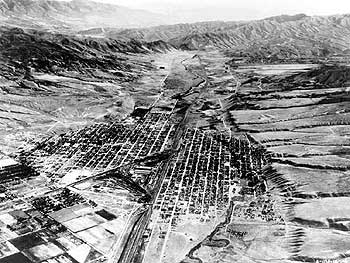|
Page
113
|
 Exquisite
aerial photograph looking southeast at Pocatello and Portneuf Narrows, about
1940. The Gould Street Overpass crosses the Union Pacific mainline in the
foreground. The city of Pocatello is laid out on a northeast-southwest grid,
parallel with the railroad tracks. By convention the streets parallel with
the tracks are said to run north-south and the cross streets east-west.
The Yellowstone branch of the Oregon Short Line (the former Utah & Northern
route) heads north-northwest to the left of the extensive railroad yards.
The rural town of Alameda is laid out on a north-south grid northwest of
Oak St. and east of Yellowstone Avenue. The northern addition to Pocatello
is the rural land northwest of Gould Street and west of Yellowstone Avenue.
Exquisite
aerial photograph looking southeast at Pocatello and Portneuf Narrows, about
1940. The Gould Street Overpass crosses the Union Pacific mainline in the
foreground. The city of Pocatello is laid out on a northeast-southwest grid,
parallel with the railroad tracks. By convention the streets parallel with
the tracks are said to run north-south and the cross streets east-west.
The Yellowstone branch of the Oregon Short Line (the former Utah & Northern
route) heads north-northwest to the left of the extensive railroad yards.
The rural town of Alameda is laid out on a north-south grid northwest of
Oak St. and east of Yellowstone Avenue. The northern addition to Pocatello
is the rural land northwest of Gould Street and west of Yellowstone Avenue.
The University airstrip is visible on the east bench east of Red Hill and the University of Idaho, Southern Branch (i.e., the "Twig").
The subdivision of West Pocatello was recently laid out. Newly planted trees can be seen in the right foreground. Three Pocatello city water reservoirs are the only developments on the West Bench, between City Creek and Cusick Creek. On the West Bench, in the lower right are some of the miles of contour ditches dug in the 1930's by the Civilian Conservation Corps.
The meandering Portneuf River winds through downtown, unencumbered by a concrete channel. The photograph shows clearly the truncated East and West Benches, which were cleaned off by the Lake Bonneville Flood 14,500 years ago. They had existed at least by 600,000 years ago when the Basalt of Portneuf Valley flowed down the course of the ancestral Bear River.
In the distance is Portneuf Narrows cut in the Bannock Range, and beyond that Marsh Valley and the Portneuf Range, with peaks Mount Bonneville and Haystack Mountain. Photo from Abe Lillibridge collection, Idaho State University.